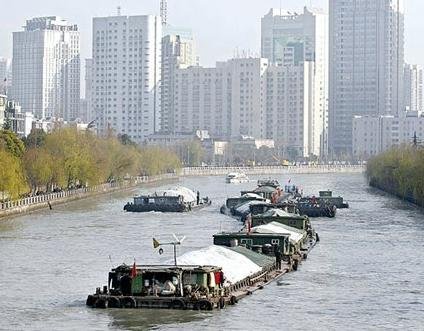
“Likonomics” Trumped by Harsh Economic and Political Realities
Publication: China Brief Volume: 13 Issue: 16

The senior cadres currently meeting for their annual brainstorming session at the seaside Beidaihe retreat are putting the finishing touches on a blueprint for seminal reforms to the Chinese economy (Duowei, August 7; South China Morning Post, August 5; Xinhua, August 5). Given the signals that have come out of the administration so far, and Xi’s grandiose, but amorphous, promise of the “China Dream,” expectations are high for the package of economic initiatives, due to be revealed in October at the Third Plenary Session of the Chinese Communist Party (CCP) Central Committee. Even as so-called “Likonomics” is attracting world-wide attention, signs of deceleration in economic growth are putting immense pressure on the Xi-Li leadership to put stability once again before economic liberalization.
Premier Li has set an overarching goal to “let go of administrative powers and return to the market whatever can best be handled by the market.” (China Daily, May 15; China News Service, May 15). The Chinese media have reported that the Central Committee Third Plenum in October will approve overhauls of economic and social policies to address the following key areas: financial, monetary and fiscal policies; creating a fair competitive environment for private enterprises; liberalizing the prices of producer goods and utilities; trimming the number and procedures of bureaucratic reviews; narrowing the income gap between rich and poor; and liberalizing the land ownership and household registration systems so as to speed up urbanization (Caijing, July 12; Xinhua, May 22). This means, among other things, retooling the three-decade-old strategy of injecting government funds into huge projects that are geared toward jacking up the GDP growth rate as well as providing employment. Li also has pledged to create a level playing field for disparate players and stakeholders including privately-owned enterprises (POEs).
The most crucial reform will be ensuring that authorities end their excessive reliance on government investment and stimulus packages to generate growth. While Chinese cadres and official economists have scolded the profligacy of the quantitative easing programs in the United States and Japan, debts owed by all levels of administrations, government financing vehicles and other government entities are estimated at 180–210 percent of GDP (Businessweek, July 13; Ming Pao [Hong Kong], April 4). An ongoing audit ordered by Beijing of the amount of debts incurred by county-level and other grassroots administrations—which are expected to be well in excess of the 10.7 trillion yuan figure the auditors established in late 2010—seems indicative of the Li cabinet’s determination to bolster financial discipline (China News Service, July 28; Hong Kong Economic Journal, July 28).
On June 20, Li and his finance team signaled their readiness for major surgery by allowing the interbank borrowing rate to spike to an unheard-of 13.44 percent—the usual rate is around three percent. A State Council statement issued at the time noted “While the economy faces many difficulties and challenges, we must promote financial reform in an orderly way to better serve economic restructuring” (China Daily, June 20; People’s Daily Online, June 20). Equally significant were the views expressed by new Finance Minister Lou Jiwei while attending the biannual Strategic and Economic Dialogue (S&ED) in Washington in early July. Lou indicated the central government might be willing to tolerate a growth rate below seven percent. The official media quoted Lou as saying on the sidelines of the S&ED sessions “there is no doubt that China can achieve the growth target, though the seven percent goal should not be considered as the bottom line” (Xinhua, July 12; Reuters, July 12) [1]. Indeed, government fixed-asset investments in urban areas grew by just 20.1 percent in the first six months of this year, the slowest pace since 2001 (Hong Kong Economic Times, July 31; Bloomberg, July 30).
Yet the nuance, if not also the substance, of policies has shifted markedly after less-than-satisfactory results for the second quarter of the year were released in early July. China’s GDP grew by an annualized rate of merely 7.5 percent in April to June, down from 7.7 percent for the first quarter of the year. Moreover, exports in June fell year-on-year by 3.1 percent, the biggest drop since the onset of the global financial crisis (China News Service, July 30; Hong Kong Economic Times, July 30). A Politburo meeting chaired by President Xi Jinping in late July referred to the imperative of “stabilizing growth”—arresting the recent downward trend of GDP expansion—in the face of “extremely complicated domestic and international conditions.” Citing a statement released after the Politburo meeting, Xinhua noted “The central authorities will continue to coordinate the multiple tasks of stabilizing growth, restructuring the economy and promoting reforms” (Xinhua, July 30; China News Service, July 30). Premier Li apparently contradicted his finance minister, stating after the release of the latest statistics that seven percent would be the “floor” or minimum level of GDP growth. The Beijing media cited Li as telling economists that “the bottom line for economic growth is 7 percent, and this bottom line must not be crossed” (Beijing News, July 23; Caixin, July 17). In the last week of July, the People’s Bank of China (PBOC), China’s central bank, pumped 136 billion yuan into markets through reverse bond repurchases and other mechanisms. This was the first time that the PBOC had injected funds directly into the money markets since February this year (Reuters, August 1; People’s Daily, July 31).
These developments seem to indicate that the government’s current policies of boosting liquidity and pumping investments into select economic sectors will not be reversed significantly even after the Third Plenum. There is a well-understood consensus among the party’s top echelons that a seven-percent growth rate is the absolute minimum for weiwen or maintaining political stability (Christian Science Monitor, July 31). While the State Council has ordered 1,400 manufacturers in sectors including steel, cement, copper and glass to curtail output because of oversupply, the Li cabinet is set to resume long-stalled investments into the nation’s ambitious railway and highway networks (Bloomberg, July 23; Huaxia Times [Beijing], July 4). Moreover, while apartment prices have been going through the roof, the State Council has avoided drastic measures to cool the real-estate bubble so as not to upset the delicate socio-economic balance (China.com, July 20; Chinavalue.net [Beijing], July 12).
Some reform measures, however, may be adopted in the fiscal, banking and taxation sectors. Last month, the PBOC liberalized its control over banks’ lending interest rates, thereby allowing financial institutions to price loans to customers according to market considerations. This step was seen as a potential lifeline to the country’s privately owned small- and medium-sized enterprises (SME), which provide an estimated 80 percent of urban jobs. There have also been talk about granting tax concessions for certain categories of POEs, as well as raising levies on the 110-odd superrich yangqi or centrally held state-owned enterprises (SOEs), which enjoy monopolies in sectors ranging from oil and gas to banking and finance (China News Service, July 22; People’s Daily, July 20).
There are, however, limits to the extent to which the nation’s POEs, including the most successful ones, can compete with state-owned enterprises (SOEs or yangqi) on the same footing. In tandem with the year-long Rectification Campaign in the CCP, whose goal is to raise the morality and patriotism of party members, a number of eminent CEOs of private enterprises have made ritualistic statements genuflecting to the party. In a controversial interview with a Hong Kong newspaper, e-commerce giant Alibaba Chairman Jack Ma reportedly praised late patriarch Deng Xiaoping’s decision to crack down on student protestors in June 1989 (Ming Pao, July 23; South China Morning Post, July 13). Chairman of heavy industrial company Sanyi, Liang Wengen, pointed out that his company would “resolutely give top priority to the interests of the party…My properties and even my life belong to the party” (Apple Daily [Hong Kong], July 22; Ta Kung Pao [Hong Kong] July 18). The fact that even these multi-billionaires have to bend over backwards to curry favor with the leader testifies to the sense of insecurity among non-state-sector businessmen. Part of this loyalty campaign could be due to the party leadership’s nervousness about private entrepreneurs giving discreet but substantial support to a range of civil-society actions. For example, dozens of POEs have provided financial help to demonstrators against the establishment of chemical factories and nuclear power facilities in Guangdong and Fujian Provinces (Hong Kong Economic Times, July 27; The Observer [Beijing] July 22).
And how about new initiatives in social policies such as abolishing the hukou or household registration policy. Doing away with this decade-old but increasingly unpopular policy will not only garner the Xi-Li administration a bonanza of good will but also facilitate Beijing’s ultra-ambitious urbanization program. The State Council reportedly is considering applying to other provinces experiments being undertaken in cities and regions such as Chongqing and Guangdong, where the distinction between urban and rural hukou is being phased out gradually. Li also is tipped to unveil more health and related social-welfare benefits so that members of the “lower classes”—including migrant workers and peasants—will feel confident enough to boost consumer spending (Xinhua, June 29; Sohu.com, May 5).
Whether Premier Li follows through with a large-scale push toward urbanization depends on Beijing’s latest thinking about government injections into the economy. A report released last month by the Chinese Academy of Social Sciences estimated that the cost of permanently settling rural workers in the cities could come up to 650 billion yuan ($106 billion) each year, which is equivalent to 5.5 percent of central government revenue. Peking University Economics Professor Li Yining, who was Li’s mentor at the famous institution, also warned that excessive spending by local governments in the name of urbanization could exacerbate the problem of regional debt (China Daily, July 30; Ifeng.com, July 30). Liberal economists, however, have suggested that reform in the rural land ownership system to allow peasants to sell their plots of land would provide rural residents with the financial means to migrate to urban areas even in the absence of massive government subsidies (Chinalawinfo.com [Beijing], July 26; People’s Daily, March 23).
While the Xi-Li leadership is still in its first year, time is running out for the kind of surgery that is needed to restructure the economy. It is a well-known fact that Beijing can no longer depend on government investment—which accounts for nearly half of GDP—to support growth. China’s incremental capital output ratio, the amount of GDP that one unit of investment produces, is declining rapidly. According to one estimate, while each yuan of new credit generated 0.71 yuan of additional GDP from 2005 to 2008, this level has sunk to just 0.3 yuan between 2009 and 2012 (Caixin.com, June 20; Asian Wall Street Journal, April 4). Moreover, the perpetuation of the existing growth model will exacerbate deep-seated social contradictions, such as the polarization between rich and poor, which are responsible for tens of thousands of “mass incidents” every year. The Chinese Academy of Social Sciences puts the total number above 100,000 (People’s Daily, December 18, 2012). The onus is on the Xi-Li administration to demonstrate outside-the-box thinking even as more Chinese seem impatient with grandiloquent slogans such as the “China Dream” and “Likonomics.”
Notes:
- Xinhua later amended its report on Lou to say there is no doubt that China can achieve this year’s growth target of 7.5 percent.





